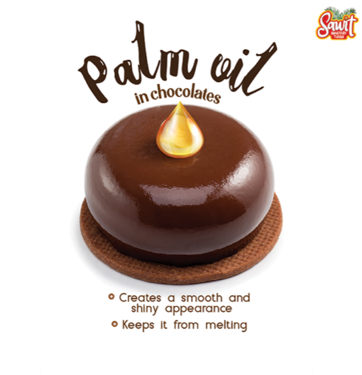 Ever wondered what makes confectioneries delicious? The sweetness from sweeteners and the melt-in-the-mouth feeling comes from fats. Palm oil in its various forms and fractions plays an important role in food manufacturing production, not just for the overall textures and mouthfeel, also to extend the shelf life of food, as well as to maintain the structural integrity. Let us walk through the functions of Malaysian palm oil and its products in some commonly consumed confectioneries!
Ever wondered what makes confectioneries delicious? The sweetness from sweeteners and the melt-in-the-mouth feeling comes from fats. Palm oil in its various forms and fractions plays an important role in food manufacturing production, not just for the overall textures and mouthfeel, also to extend the shelf life of food, as well as to maintain the structural integrity. Let us walk through the functions of Malaysian palm oil and its products in some commonly consumed confectioneries!
Chocolate
Chocolate is one of the most loved confectioneries around the world, especially during holiday seasons. One main component that makes chocolate indulgent and decadent is the addition of fats. Traditionally, cocoa butter is added into chocolate production. However, due to the cost and insufficient supply, cocoa butter alternatives continue to be a key solution for long term profitable production. They are easily modified and more cost effective during production, yet still able to mimic the functions of cocoa butter. There are a few types of cocoa butter alternatives, in which, Cocoa Butter Equivalent (CBE) is the most compatible alternative to cocoa butter. It is usually derived from palm oil, palm kernel oil, shea, sal nut and mango kernel fat. 
The biggest advantage of using palm fat as an alternative is due to its availability and potential cost reduction of the overall confectionery formulation. Also, cocoa butter and palm-based cocoa butter substitutes share the same unique melting characteristics, in which they remain solid at room temperature but melts at body temperature. The similar melting characteristic of palm-based cocoa butter alternatives gives a smooth and creamy texture in the mouth, just like cocoa butter. It is also widely used for coatings in chocolate.
Biscuits & Cookies
 In biscuit and cookie production, fats play vital roles to produce the crispy and crumbly texture. Typically, fats in solid or semi-solid state at room temperature are preferred as it makes dough handling and processing easier and more desirable. The semi-solid nature of palm oil makes it an excellent choice to manufacture confectionery fats such as palm-based margarine and shortenings, without the need to undergo partial hydrogenation process that produces harmful trans-fat. It is also heat stable and has high oxidative stability, which means that the end product will have a longer shelf life. Palm oil is ideal for baking as it is free of trans-fat and has high melting point, therefore it could withstand the mixing condition of dough of cookies, shortbread, biscuits, as well as able to trap air during baking and impart desired texture to baked products.
In biscuit and cookie production, fats play vital roles to produce the crispy and crumbly texture. Typically, fats in solid or semi-solid state at room temperature are preferred as it makes dough handling and processing easier and more desirable. The semi-solid nature of palm oil makes it an excellent choice to manufacture confectionery fats such as palm-based margarine and shortenings, without the need to undergo partial hydrogenation process that produces harmful trans-fat. It is also heat stable and has high oxidative stability, which means that the end product will have a longer shelf life. Palm oil is ideal for baking as it is free of trans-fat and has high melting point, therefore it could withstand the mixing condition of dough of cookies, shortbread, biscuits, as well as able to trap air during baking and impart desired texture to baked products.
Another common palm-based confectionery fats used in biscuit production are palm kernel oil and palm kernel stearin. Both ingredients are widely used in making biscuit cream fillings, especially in sandwich-type biscuits, as well as in creating the glossy and attractive finishing appearance of cream crackers. Palm-based confectionery fats are also significant in giving a good mouthfeel, such as flakiness and crunchiness, and hence eliminates the pasty mouthfeel from flour.
Ice Cream
 Ice cream is one of the most popular treats, not just among children, but also much loved by adults. Traditionally, ice cream is made with milk fat, but as the demand for ice cream is getting higher, dairy fat substitute is now commonly used as an alternative.
Ice cream is one of the most popular treats, not just among children, but also much loved by adults. Traditionally, ice cream is made with milk fat, but as the demand for ice cream is getting higher, dairy fat substitute is now commonly used as an alternative.
Ice cream production involves incorporating oil and water, to generate oil-in-water emulsion. It is crucial for the fat component of ice cream to have sharp melting properties to ensure good organoleptic characteristics. Particularly, palm-based fat such as Malaysian palm oil and palm kernel oil fits nicely as a dairy fat substitute in ice cream as they are comparable to milk fat in their appearance, texture and melting properties. It is also suitable for non-dairy ice cream formulations.
By using palm-based fat in ice cream production, it gives the end product its desired smooth, creamy and velvety texture. It also helps to ensure good flavour stability in the finished product.
Prepared by Vicky

